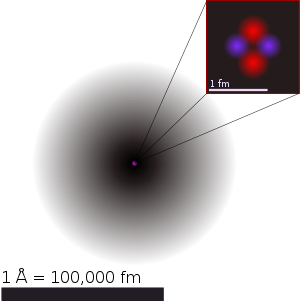 |
| Helium nucleus surrounded its electron cloud |
The size does vary according to the atom in question, Uranium atom nuclei are about 8 times larger than a hydrogen nuclei, which only contains a single proton. The largest come in at about 15 fm (Femto metres).
15 fm is tiny, it is about 10,000 times smaller than an atom, and this is why people often say that atoms are mostly made up of nothing. I think this is wrong. Atoms cannot be any smaller than they are, you cannot make them any smaller. You increase the pressure and eventually atoms will collapse into neutrons, this is what we believe happens in neutron stars. They do not collapse into smaller atoms.
So I think that they are actually as full as they possibly can be. They are full to capacity, which got me pondering to what they are actually full off.
Take the hydrogen atom, a single proton and a single electron. The proton is tiny and the electron is also very tiny. They carry equal but opposite charges. The proton is about 1830 times the mass of the electron. The interact to create the hydrogen atom. They both spin. This leads us to imaging the proton like a large planet with a small satellite, the electron in orbit around it, which is wrong*, but looks nice.
The size of the hydrogen atom is about 0.03 nanometers, which is huge compared with either the electron or the proton, yet this is the smallest it can possibly be.
The best explanation we currently have for the behaviour of an atom comes from quantum mechanics (QM). I have been told that the Heisenberg Uncertainty Principle (HUP) explains why the electron, which is negatively charged, does not drop straight into the positively charged proton to form a neutron, after all opposites should attract. I've never really understood or been convinced by the argument, seems a little odd to me. That said
Atoms do change size as we move through the period table, Hydrogen is the smallest and the largest has a radius almost 10 times the size of Hydrogen, which is comparable to the change in size of the atomic nucleus for the two extremes. Is this coincidental or is there something in this?
The reason we think the atoms change size is due to the electrons having to pack in around the atomic nucleus. Hydrogen has a single electron so it is small, Uranium has a whopping 92 electrons surrounding each atomic nucleus, so it is larger!
All atoms are small compared to the wavelength of visible light, which is about 1000 times bigger, which really baffles me, because visible light should not be able to see something as small as an atom, and yet interactions occur between visible light and atoms. Just take a look in the mirror! This is just visible light striking atoms and being reflected back.
The interaction of light and atoms is currently explained by Quantum electrodynamics or QED for short. A brilliant theory that has been tested over and over and has come through time and again. Something I will cover in another post.
So what is the point of this post?
Atomic nuclei are typically 10,000 time smaller than atoms, which are in turn 1,000 times smaller that visible light. So from visible light to atomic nuclei that is a change is scale of 10 million. Let's see if we can get that in perspective. Imagine a ball with a diameter of about 1 metre then the wavelength of light would be comparable to the width of the planet earth. Which is once again, too big for us to image.
I suppose the point is, than even on tiny scales, those of visible light, atoms and nuclei, the distance from the largest to the smallest is absolutely massive and is so big to be beyond our imagination.
What I still can't figure out is why atoms are the size they are and why nuclei are the size they are, why approximately 10,000 times, why not 50, or 5,000,000? will have to ponder, when I come up with something I'll let you know.



No comments:
Post a Comment